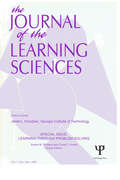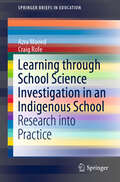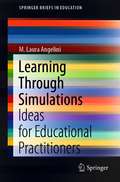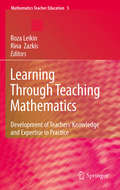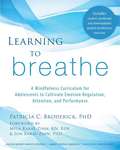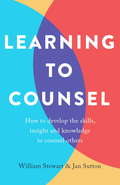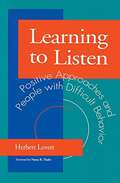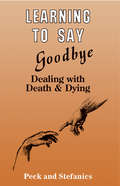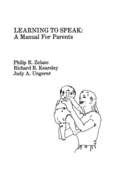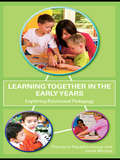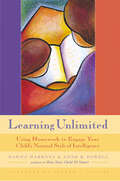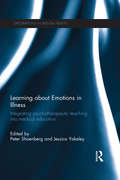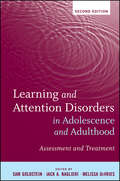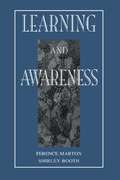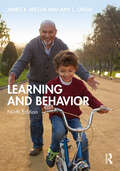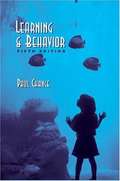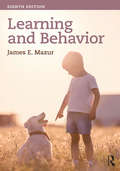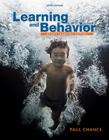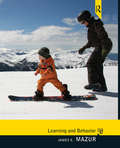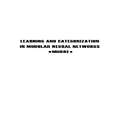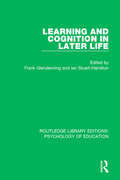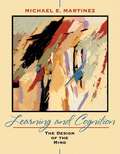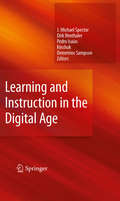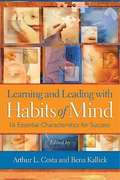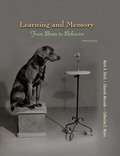- Table View
- List View
Learning Through Problem Solving: A Special Double Issue of the Journal of the Learning Sciences
by Janet L. KolodnerThe articles in this special issue represent the findings of researchers working in classroom settings to explore key issues in learning through problem solving. Although they vary in the domains being studied, the age of students, and the methods they employ, there are numerous common themes that can inform both theory and practice. The authors have grappled with the complex task of putting problem-based curricula into practice. They report here the difficulties they faced, the factors contributing to their successes, and the lessons they have learned.
Learning Through School Science Investigation in an Indigenous School: Research into Practice (SpringerBriefs in Education)
by Azra Moeed Craig RofeThis book presents the findings of a case study conducted in a Māori medium school where a space was created for Pūtaiao (Western science) teaching and learning from year 1 to 13. Science is currently taught in Te Reo Māori in primary school and in English in secondary school, and evidence suggests that students are engaging in science education, learning to investigate, and achieving in science. In New Zealand, most students attend English medium state schools; however, approximately 15% of indegenous students attend Māori medium schools. These schools are underpinned with Kura Kaupapa Māori philosophy, which is culturally specific to Māori and aims to revitalise the Māori language, and Māori knowledge and culture. Māori students’ engagement and achievement continues to be a challenge for both mainstream and Māori medium schools, teachers and students due to lack of access to science teachers who can teach in Te Reo Māori. School leaders and whanau (families) believed that by year 9 (age 13) their students had developed their identity as Māori, and were proficient in Te Reo Māori. They wanted their students to have the option to learn science, experience success and have the choice to conitnue in science, so they made the difficult decision for science to be taught in English in secondary school. The book discusses how teachers in indigenous schools, who have extensive knowledge of culture and context specific pedagogies, can gain confidence to teach science through collaboration with and support from researchers with whom they have developed strong professional relationships.
Learning Through Simulations: Ideas for Educational Practitioners (SpringerBriefs in Education)
by M. Laura AngeliniThis book is written for teacher educators who are looking for strategies to teach a foreign or second language in a more meaningful way whilst applying active methodologies to develop critical thinking skills. The book is designed to guide the readers through a series of simulations that provide challenging learning opportunities, similar to the ones experienced in real life, whereby each simulation is designed to support participants’ language and critical thinking skills and their abilities as future teachers. The book first introduces the concept of simulations in education. Then it provides examples of fully developed simulations and instructions for their implementation, a template for the readers to create their own simulations, as well as suggestions for peer classroom observation and professional development. Finally, three case studies exploring student learning through simulations are presented. This book is a useful teaching resource for teacher instructors, English as a Second Language/English as a Foreign Language students, secondary school teachers and for language institutions.
Learning Through Teaching Mathematics
by Rina Zazkis Roza LeikinThis volume explores how and when teachers' knowledge develops through teaching. The book presents international views on teachers' learning from their practice; the chapters are written by mathematicians or mathematics educators from Brazil, Canada, Israel, Mexico, UK, and USA. They address diverse content - numerical literacy, geometry, algebra, and real analysis - and a variety of levels - elementary school, secondary school, undergraduate mathematics, and teacher education courses. The authors employ different methodological tools and different theoretical perspectives as they consider teaching in different learning environments: lecturing, small group work on problems and tasks, mathematical explorations with the support of technological software, or e-learning. Despite these differences, the authors exemplify and analyze teachers' learning that occurred and address the question: "What kinds of knowledge are developed as a result of teaching mathematics and what are the factors that support or impede such development?" Further, the chapters explore interactions and interrelationships between the enhancement of mathematical and pedagogical knowledge. The important and original contribution of this book is that it ties together the notions of teachers' knowledge and complexity of teacher's work, while presenting them from a relatively unexplored perspective - learning through teaching mathematics.
Learning To Breathe: A Mindfulness Curriculum For Adolescents To Cultivate Emotion Regulation, Attention, And Performance
by Jon Kabat-Zinn Myla Kabat-Zinn Patricia BroderickDisruptive behavior in the classroom, poor academic performance, out-of-control emotions: if you work with adolescents, you are well-aware of the challenges this age group presents. What if there was a way to calm these students down and arm them with the mindfulness skills needed to really excel in school and life? <p><p> Written by mindfulness expert and licensed clinical psychologist Patricia C. Broderick, Learning to Breathe is a secular program that tailors the teaching of mindfulness to the developmental needs of adolescents to help them understand their thoughts and feelings and manage distressing emotions. Students will be empowered by learning important mindfulness meditation skills that help them improve emotion regulation, reduce stress, improve overall performance, and, perhaps most importantly, develop their attention. The book also includes a website link with student handouts and homework assignments, making it an ideal classroom tool. <p> The book integrates certain themes of mindfulness-based stress reduction (MBSR), developed by Jon Kabat-Zinn, into a program that is shorter, more accessible to students, and compatible with school curricula. Students will learn to pay attention in the moment, manage emotions as they are perceived, and gain greater control over their own feelings and actions. These mindfulness practices offer the opportunity to develop hardiness in the face of uncomfortable feelings that otherwise might provoke a response that could be harmful (e.g. acting out by taking drugs, displaying violent behavior or acting in by becoming more depressed). <p> This easy-to-use manual is designed to be used by teachers, but can also be used by any mental health provider teaching adolescents emotion regulation, stress reduction and mindfulness skills. The author is a graduate of the MBSR advanced practicum at the Center for Mindfulness in Massachusetts, led by Jon Kabat-Zinn. She is also a clinical psychologist and a certified school psychologist and counselor for grades K-12. In the book, Broderick calls on her years of experience working with adolescents to outline the best strategies for dealing with disruption in the classroom and emotions that are out of hand. <p> The book is structured around six themes built upon the acronym BREATHE, and each theme has a core message. The program allows for themes to be delivered in 6 longer or 18 shorter sessions, depending upon time and needs of students. The 6 core lessons are: Body, Reflection, Emotions, Attention, Tenderness, and Healthy Mind Habits. <p> Learning to Breathe is the perfect tool for empowering students as they grapple with the psychological tasks of adolescence.
Learning To Counsel, 4th Edition: How to develop the skills, insight and knowledge to counsel others
by William Stewart Jan SuttonDrawing on their numerous years experience as counsellors, tutors, and writers, Jan Sutton and William Stewart introduce readers to the basic principles that underpin counselling practice. Written in a clear, concise and jargon-free style, and with its wealth of case studies, examples of skills in practice, and practical exercises, this new edition is an ideal text for those embarking on a counselling or psychotherapy course, trainee counsellors, counselling tutors to use in training, professionals working in the area of health care, management and education, and counsellors working in the voluntary sector. It provides insight into various counselling approaches; clarifies the nature of counselling and the role of the counsellor, and assists readers to develop a repertoire of key counselling skills and qualities, such as active listening, genuineness, unconditional positive regard, empathy, goal-setting, etc. The book also addresses the important issues of ongoing supervision to enhance counselling practice, and counsellor self-care to reduce the risk of burnout.
Learning To Listen: Positive Approaches And People With Difficult Behavior
by Herbert Lovett Nancy ThalerThis nontechnical and absorbing text describes how the interactive process of "learning to listen" provides practical alternatives to overly controlling behavior modification techniques. Written for support and other service providers working with people with intellectual disabilities, this book includes compelling and detailed case studies that illustrate possible positive approaches and reveal how people with disabilities can take control of their lives.
Learning To Say Goodbye: Dealing With Death And Dying
by Rosalie Peck Charlotte StefanicsFirst published in 1987. Routledge is an imprint of Taylor & Francis, an informa company.
Learning To Speak: A Manual for Parents
by P. R. Zelazo R. B. Kearsley J. A. UngererFirst published in 1984. Routledge is an imprint of Taylor & Francis, an informa company.
Learning Together in the Early Years: Exploring Relational Pedagogy
by Janet Moyles Theodora PapatheodorouRelational pedagogy underpins the core principles of both the cognitive, and social/emotional development of young children, as evidenced in the Reggio Emilia preschools and the Te Whariki curriculum in New Zealand. Emphasising the links between, people, places and ideas and the effects of these on education, educators and learners, it is integral to the English Early Years Foundation Stage, and forms the basis for early years provision around the world. This book brings together contributions from international experts on early years education to explore and debate relational pedagogy across different countries and in the context of a broad international field. The three sections of the book cover the following areas: culture, environment and adult child relationships - how children and adults relate to the culture, ethos and environment in which they function; adult-child relationships - how education and care environments directly relate to learning and teaching; adult-adult relationships for professional development - in training situations and parental partnerships. The book will be of interest to all those who want to delve deeper into how these interactions affect teaching and learning and to understand how the context can have its own impact on pedagogical outcomes. Researchers in early years education and students on early childhood education courses will find much here to inspire and challenge their thinking.
Learning Unlimited: Using Homework to Engage Your Child's Natural Style of Intelligence
by Dawna Markova Anne R. PowellFrom the authors of How Your Child is Smart, a guide to creating a natural learning environment for a child at home.Natural learning starts at home. Anyone who spends time with young children recognizes their natural intelligence and resilient passion to learn. But as they try to meet the pressures and expectations of school, natural learning diminishes. Does it have to be that way? According to teachers Dawna Markova and Anne R. Powell, absolutely not. Whether a parent or educator, Learning Unlimited helps transform the homework hassle from a nightly struggle to an engaged learning initiative that uncovers the unique gifts of your child’s mind.Learning from your child’s natural motivation. Filled with practical advice and compassionate support, this book is designed to honor your child’s innate intelligence with family engaged learning strategies. In Learning Unlimited, veteran teachers unveil how learning from homework can also function as a joint inquiry into your child’s special gifts. Designed for optimal parental involvement in education, this guide helps parents give children a competitive advantage by cultivating a life-long love of learning.Praise for Learning Unlimited“Markova and Powell . . . are proponents of the teaching movement that uses visual, audio and kinesthetic presentations to educate. Proposing that each child has his or her own personal operating system (POS) to receive, integrate and express learning, the authors suggest ways by which related classroom tactics can be applied to homework . . . . This primer is brimming with fun, unusual and practical ideas likely to benefit parents, students and educators.” —Publishers Weekly
Learning about Emotions in Illness: Integrating psychotherapeutic teaching into medical education (Explorations in Mental Health)
by Jessica Yakeley Peter ShoenbergGood communication between the doctor and patient is essential for the patient to establish a trusting relationship with their doctor and to make the best use of the appropriate treatment. Traditional methods for teaching communication skills have focused on simulated clinical situations in which students learn how to improve their communication, with actors playing the part of the patients, rather than from live experiences with patients. Psychodynamic psychotherapy, with its emphasis on learning to reflect on experiences, offers the student the possibility of learning from a real experience with a patient. Such opportunities allow students to learn directly about patients’ emotions, as well as to appreciate their own emotional responses to illness and to communicate better with their patients. In this book, Peter Shoenberg, Jessica Yakeley, and their contributors who include students and teachers, discuss two different teaching approaches developed at University College London to help medical students understand the role of emotions in illness, communicate more effectively, and gain a deeper understanding of the doctor patient relationship. The benefits of Ball, Wolff and Tredgold’s Student Psychotherapy Scheme are considered alongside Shoenberg and Suckling’s short term student Balint discussion group scheme to provide clear guidance about how psychotherapeutic understanding can be used to inform medical education, with positive results. At a time when medicine is becoming increasingly technological and there is a growing demand by the public for more psychologically minded doctors, this book will be a key resource for physicians, general practitioners, psychologists, psychiatrists and psychotherapists who are involved in medical teaching and for medical students.
Learning and Attention Disorders in Adolescence and Adulthood
by Sam Goldstein Jack A. Naglieri Melissa DevriesFully revised coverage with the most current diagnoses and treatments for adolescents and adults living with learning and attention disordersReflecting the most recent and relevant findings regarding Learning Disabilities (LD) and Attention-Deficit/Hyperactivity Disorder (ADHD), this Second Edition of Learning and Attention Disorders in Adolescence and Adulthood provides practitioners in the fields of education and mental health with a set of practical guidelines to assist in the assessment, diagnosis, consultation, and treatment of adolescents and adults struggling with LD and ADHD. The new edition includes: An emphasis on working from strengths-adapting to disabilities and dealing with them successfully on a daily basis New coverage of the causes and long-term implications of LD and ADHD in adolescents and adulthood New chapters on treatment effectiveness; building resiliency and shaping mindsets; cognitive therapy; and strategic life coaching to help guide individuals with LD and ADHD Contributions from leading researchers, including Noel Gregg, Russell Barkley, Kevin Antshel, and Nancy MatherDrawing on evidence-based techniques to meet the pragmatic demands for intervention, the Second Edition guides school psychologists, counselors, and educators in promoting positive change for adolescents and adults with LD and ADHD as they strive for success in school, work, and home settings.
Learning and Awareness (Educational Psychology Series)
by Ference Marton Shirley BoothThis book stems from more than 25 years of systematic research into the experience of learning undertaken by a research team trying to account for the obvious differences between more or less successful instances of learning in educational institutions. The book offers an answer in terms of the discovery of critical differences in the structure of the learner's awareness and critical differences in the meaning of the learner's world. The authors offer a detailed account of the empirical findings that give rise to theoretical insights, and discuss the particular form of qualitative research that has been employed and developed. The form of learning that is the object of study is considered to be the most fundamental form -- namely a change in the learner's way of seeing, experiencing, handling, and understanding aspects of the world. The need for rigorous analysis of learning of specific subject matter, the individual construction of knowledge, and its social and cultural embeddedness -- the defining features of rival approaches into research on learning -- are reconciled from the approach adopted here into an intertwined and whole experience of learning. The learner's experience is always one of learning something, in some way, and in some context; by holding the learner's experience of learning as the focus of study throughout -- and not studying the learning of the content and the acts and the context as separate and distinct focuses -- the content, the act, and the context remain united as constituents of the learner's experience. By empirically revealing critical differences in the ways of experiencing these aspects of learning, and by developing a theoretical framework for the dynamics through which change comes about in the learner's awareness, this book gradually leads the reader to a powerful new view of learning. Equipped with the analytical tools and conceptual apparatus to be found in this book, the reader will be empowered to learn and to assist others to learn by creating environments conducive to the most fundamental form of learning: experiencing aspects of the world in new ways.
Learning and Behavior
by James E. Mazur Amy L. OdumLearning and Behavior reviews how people and animals learn and how their behaviors are changed because of learning. It describes the most important principles, theories, controversies, and experiments that pertain to learning and behavior that are applicable to diverse species and different learning situations. Both classic studies and recent trends and developments are explored, providing a comprehensive survey of the field. Although the behavioral approach is emphasized, many cognitive theories are covered as well, along with a chapter on comparative cognition. Real-world examples and analogies make the concepts and theories more concrete and relevant to students. In addition, most chapters provide examples of how the principles covered have been employed in applied and clinical behavior analysis. The text proceeds from the simple to the complex. The initial chapters introduce the behavioral, cognitive, and neurophysiological approaches to learning. Later chapters give extensive coverage of classical conditioning and operant conditioning, beginning with basic concepts and findings and moving to theoretical questions and current issues. Other chapters examine the topics of reinforcement schedules, avoidance and punishment, stimulus control and concept learning, observational learning and motor skills, comparative cognition, and choice. Thoroughly updated, each chapter features many new studies and references that reflect recent developments in the field. Learning objectives, bold-faced key terms, practice quizzes, a chapter summary, review questions, and a glossary are included. The text is intended for undergraduate or graduate courses in psychology of learning, (human) learning, introduction to learning, learning processes, animal behavior, (principles of) learning and behavior, conditioning and learning, learning and motivation, experimental analysis of behavior, behaviorism, and behavior analysis.
Learning and Behavior (5th edition)
by Paul ChancePer the author: The theme of this edition is that learning is a biological mechanism that aids survival. My goal was to write a text that would cover the course contents in the theory and research of behavior and learning. This book is an instructional tool, not a reference book.
Learning and Behavior (8th Edition): Eighth Edition
by James E. Mazur<p>This book reviews how people and animals learn and how their behaviors are changed as a result of learning. It describes the most important principles, theories, controversies, and experiments that pertain to learning and behavior that are applicable to diverse species and different learning situations. Both classic studies and recent trends and developments are explored, providing a comprehensive survey of the field. <p>Although the behavioral approach is emphasized, many cognitive theories are covered as well, along with a chapter on comparative cognition. Real-world examples and analogies make the concepts and theories more concrete and relevant to students. In addition, most chapters provide examples of how the principles covered have been applied in behavior modification and therapy. <p>Thoroughly updated, each chapter features many new studies and references that reflect recent developments in the field. Learning objectives, bold-faced key terms, practice quizzes, a chapter summary, review questions, and a glossary are included. <p>The volume is intended for undergraduate or graduate courses in psychology of learning, (human) learning, introduction to learning, learning processes, animal behavior, (principles of) learning and behavior, conditioning and learning, learning and motivation, experimental analysis of behavior, behaviorism, and behavior analysis.</p>
Learning and Behavior: Active Learning Edition (6th edition)
by Paul ChanceThis undergraduate textbook introduces the natural science approach to behavior and describes the efforts of researchers to understand the kinds of experiences that produce learning, the circumstances under which learning in one situation carries over to another situation, the effects of different reinforcement schedules, the durability of learned behavior, and the limitations of learning.
Learning and Behavior: Seventh Edition
by James E. MazurThis book reviews how people and animals learn and how their behaviors are later changed as a result of this learning. Nearly all of our behaviors are influenced by prior learning experiences in some way. This book describes some of the most important principles, theories, controversies, and experiments that pertain to learning and behavior that are applicable to many different species and many different learning situations. Many real-world examples and analogies make the concepts and theories more concrete and relevant to the students. In addition, most of the chapters include sections that describe how the theories and principles have been used in the applied field of behavior modification. Each chapter in the seventh edition was updated with new studies and new references that reflect recent developments in the field. The book includes a number of learning aids for students, including a list of learning objectives at the beginning of each chapter, practices quizzes and review questions, and a glossary for all important terms. Learning & Behavior covers topics such as classical and operant conditioning, reinforcement schedules, avoidance and punishment, stimulus control, comparative cognition, observational learning, motor skill learning, and choice. Both the classic studies and the most recent developments and trends in the field are explored. Although the behavioral approach is emphasized, many cognitive theories are covered as well along with a chapter on comparative cognition.? Upon completing this book readers will be able to:understand the field of learning and discuss real-world applications of learning principles.
Learning and Categorization in Modular Neural Networks
by Jacob M.J. MurreThis book introduces a new neural network model called CALM, for categorization and learning in neural networks. The author demonstrates how this model can learn the word superiority effect for letter recognition, and discusses a series of studies that simulate experiments in implicit and explicit memory, involving normal and amnesic patients. Pathological, but psychologically accurate, behavior is produced by "lesioning" the arousal system of these models. A concise introduction to genetic algorithms, a new computing method based on the biological metaphor of evolution, and a demonstration on how these algorithms can design network architectures with superior performance are included in this volume. The role of modularity in parallel hardware and software implementations is considered, including transputer networks and a dedicated 400-processor neurocomputer built by the developers of CALM in cooperation with Delft Technical University. Concluding with an evaluation of the psychological and biological plausibility of CALM models, the book offers a general discussion of catastrophic interference, generalization, and representational capacity of modular neural networks. Researchers in cognitive science, neuroscience, computer simulation sciences, parallel computer architectures, and pattern recognition will be interested in this volume, as well as anyone engaged in the study of neural networks, neurocomputers, and neurosimulators.
Learning and Cognition in Later Life (Routledge Library Editions: Psychology of Education)
by Ian Stuart-Hamilton Frank GlendenningOriginally published in 1995, within the previous decade there had been significant developments in our understanding of the learning and motivation, together with the conceptual and cognitive development, of older adults. This understanding had been enhanced by findings from longitudinal studies which were now becoming available. These findings demonstrated the gains that had been made in research. In the past, inappropriately conceived studies have led to the perpetuation of myths and stereotypes about the intellectual development of older people. Special attention is paid in this book to changing perceptions of ageing and intelligence, learning aptitude, memory and intelligence testing. The important topic of ageing and wisdom is also discussed.
Learning and Cognition: The Design of the Mind
by Michael E. MartinezWhat is the design of the mind? What does that design imply for education? This comprehensive and engaging introduction to human learning and its applications to education focuses on these vital questions by exploring the theories of knowledge, complex cognition, and human intelligence, presenting a clear and interesting overview of the human mind through multiple theoretical lenses. The author delineates how the mind has a clear design, or architecture, that explains simple acts of memory and complex cognition, to highly creative acts and leaps of scientific or artistic insight. Topics covered throughout the text include: memory, motivation, cognitive development, the brain, and intelligence. Unique to this text, the author has provided an interdisciplinary chapter dedicated to theories of knowledge, extended coverage of expert-novice differences and talent development, and a chapter devoted to intelligence. Readers will appreciate special features like Learning Strategies which cover specific application of the theories to classroom practice, and Interest Magnets which explore fascinating topics such as photographic memory, sleep learning, and Einstein's brain. Written like a narrative, Learning and Cognition: The Design of the Mind will delight its readers' interest and attention as they learn about the theories of human learning and cognition and the improvement of the mind through education.
Learning and Instruction in the Digital Age
by J. Michael SpectorInstruction tailored to the individual student, learning and teaching outside the limits of time and space--ideas that were once considered science fiction are now educational reality, with the prospect of an intelligent Web 3.0 not far distant. Alongside these innovations exists an emerging set of critical-thinking challenges, as Internet users create content and learners (and teachers) take increased responsibility in their work. Learning and Instruction in the Digital Age nimbly balances the technological and pedagogical aspects of these rapid changes, gathering papers from noted researchers on a wealth of topics relating to cognitive approaches to learning and teaching, mental models, online learning, communications, and innovative educational technologies, among them: Cognition and student-centered, Web-based learning, The progression of mental models throughout a course of instruction, Experiencing education with 3D virtual worlds, Expanding educational boundaries through multi-school collaboration, Adapting e-learning to different learning styles, The student blog as reflective diary. With its blend of timely ideas and forward thinking, Learning and Instruction in the Digital Age will enrich the work of researchers in educational psychology, educational technology, and cognitive science.
Learning and Leading With Habits of Mind: 16 Essential Characteristics for Success
by Arthur L. Costa Bena KallickIn Learning and Leading with Habits of Mind, noted educators Arthur L. Costa and Bena Kallick present a comprehensive guide to shaping schools around Habits of Mind. The habits are a repertoire of behaviors that help students and teachers successfully navigate the various challenges and problems they encounter in the classroom and in everyday life. The Habits of Mind include: Persisting, Managing impulsivity, Listening with understanding and empathy, Thinking flexibly, Thinking about thinking (metacognition), Striving for accuracy, Questioning and posing problems, Applying past knowledge to new situations, Thinking and communicating with clarity and precision, Gathering data through all senses, Creating, imagining, innovating, Responding with wonderment and awe, Taking responsible risks, Finding humor, Thinking interdependently, Remaining open to continuous learning.
Learning and Memory
by Mark A. Gluck Eduardo Mercado Catherine E. MyersWith its modular organization, consistent chapter structure, and contemporary perspective, this groundbreaking survey is ideal for courses on learning and memory, and is easily adaptable to courses that focus on either learning or memory. Instructors can assign the chapters they want from four distinctive modules (introduction, learning, memory, and integrative topics), with each chapter addressing behavioral processes, then the underlying neuroscience, then relevant clinical perspectives. The book is further distinguished by its full-color presentation and coverage that includes comparisons between studies of human and nonhuman brains. The new edition offers enhanced pedagogy and more coverage of animal learning.
